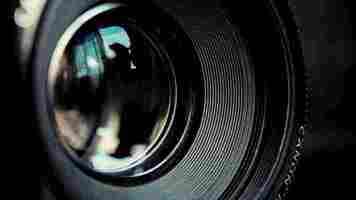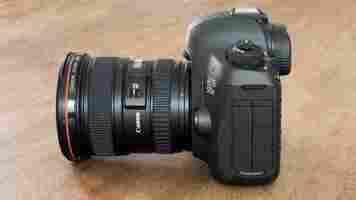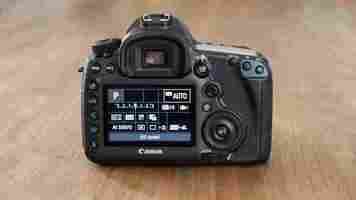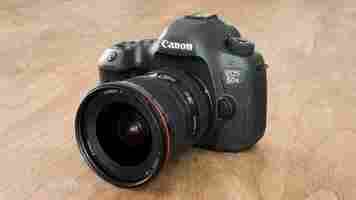Canon 5Ds review
Three years ago we got dewy eyed about the Canon EOS 5D Mark III , a full-frame SLR that scored straight As for image quality, features and performance. A lot has happened since then, though, not least the arrival of the Nikon D750 . The two cameras are closely matched for image quality, performance and features, but the D750 has a tilting screen, Wi-Fi and costs just £1500. If there's one thing more alluring than a full-frame SLR, it's a full-frame SLR with a superb lens attached. A cheaper body means more cash to spend on glass.
Canon has hit back with the EOS 5Ds, which comes fitted with a 50-megapixel sensor – the highest resolution to date for a full-frame SLR. This equates to 8,688x5,792, which is enough for A1 prints at 250dpi. There can't be many photographers who feel the need to print at such large sizes, but there's something reassuring about never having to worry that your images aren't detailed enough. 50 megapixels are great for large group portraits – perhaps at weddings – so you can zoom in to see people's faces. It allows judicious use of the crop tool while still maintaining plenty of detail. It's also worth noting that a sensor's output is always crisper after it's been resized downwards, due to the way colour sensors handle anti-aliasing and only record red, green or blue colour channels at each pixel. A 50-megapixel sensor should produce crisper 24-megapixel photos than a 24-megapixel sensor.

It's not enough just to pack lots of pixels onto a sensor, though. The rest of the camera has to deliver to the same degree. There's some encouraging attention to detail that demonstrates Canon's commitment to the cause. The press release refers to a reinforced chassis, baseplate and tripod lug to improve rigidity. The mirror flip-up mechanism has been redesigned and it's possible to add a fixed delay of between 1/8 and two seconds between mirror lock and shutter release. All of this should help to reduce vibrations when shooting with a tripod.
There's no shortage of superb Canon EF lenses to choose from, and I'd expect them to live up to the demands of this sensor. The 50-megapixel full-frame sensor has the same pixel density as a 20-megapixel APS-C sensor, so this sensor requires a similar level of lens sharpness as the current generation of 24-megapixel cropped-sensor SLRs.

The same could be argued of the demands placed on autofocus, but this is an area where cropped-sensor SLRs can struggle to deliver pixel-perfect results. The 5Ds is fitted with the same 61-point autofocus sensor as the 5D Mark III and the flagship EOS 1D X. It's a dense array of points, and 41 of them are cross-type for increased sensitivity. When shooting with an f/2.8 or brighter lens, the central column of five points are dual-cross-type for extremely accurate focusing.
Meanwhile, the 5Ds's metering has been upgraded compared to the 5D Mark III, with a 150,000-pixel sensor that measures red, green, blue and infrared colour channels. It's a big step up from the Mark III's 63-zone metering sensor, and should lead not only to improved metering but also superior subject tracking for autofocus. In my tests, the 5Ds's subject tracking was good but not brilliant. We didn't have both cameras to compare directly but our recollection is that the Nikon D750's tracking mode was more reliable.
Sharp photos also depend on a suitable shutter speed. It might be reasonable to assume that anyone considering a £3,000 camera knows how to manage exposure settings, but I still prefer a camera that makes intelligent decisions without intervention. The 5Ds's Auto ISO mode is more customisable than before. The minimum shutter speed can be set manually or left to be adjusted dynamically depending on the focal length. Unlike on the 5D Mark III, it's possible to shift these dynamic speeds towards slower or faster values. However, the Auto ISO setting doesn't respond to motion of the subject or camera. For moving subjects it's essential to set the shutter or ISO speed manually.
With a bigger sensor comes higher demands on data management. Files are about twice the size as the 5D Mark III's, with JPEGs varying from 10 to 30MB depending on the complexity of the scene and RAW files weighing in at around 55MB. Higher-resolution sensors (and their processing needs) tend to draw more power, and sure enough, battery life has fallen from 950 to 700 shots.
Continuous performance also takes a hit, although the move to a faster processor means it's not as drastic as it could have been. While the 5D Mark III shoots at 6fps, the 5Ds manages 5fps. It slowed after 43 JPEGs to 3.1fps when testing with an SDHC card (rated at 94MB/s), but continued for over 100 JPEGs when testing with a CompactFlash card (rated at 90MB/s). RAW continuous shooting lasted for 18 frames before slowing to around 2fps.
Ergonomics and video
Otherwise, the 5Ds is virtually identical to the 5D Mark III. That's by no means a criticism as far as ergonomics are concerned. The curved magnesium alloy shell feels extremely sturdy and comfortable to hold. There's a strip of buttons along the top plate that reassign the command dial and rear wheel to various functions. With all of these settings plus autofocus and exposure relayed through the viewfinder, there's rarely any need to take your eye from the viewfinder while shooting.

The viewfinder's 0.71x magnification gives a big, detailed preview of the scene that makes composing shots a real pleasure. It's not necessarily big enough for pixel-accurate manual focus adjustment, though. For this it's better to switch to live view on the 3.2in screen, with the option to magnify the preview by up to 16x.
The headline video specifications are unchanged, with 1080p capture at 24, 25 and 30fps in AVC format, plus an All-Intra codec that virtually eliminates compression artefacts with its 90Mbit/s bit rate. However, will all that processing power on board it's disappointing not to find 4K video capture, or even 1080p at 50fps.
At least video autofocus has been upgraded from the chugs and jitters displayed by the 5D Mark III. However, only two of Canon's STM range of lenses – designed for smoother performance for video – are compatible with full-frame SLRs. The 5Ds loses a couple of video-related features compared to the Mark III. There's no headphone out, presumably due to the move to a larger USB 3 socket, and the HDMI output can't send a clean feed to an external monitor or recorder.
